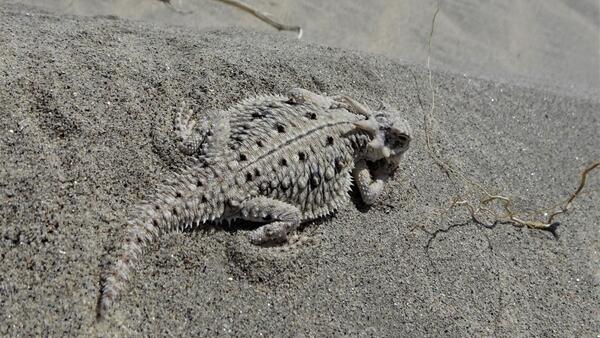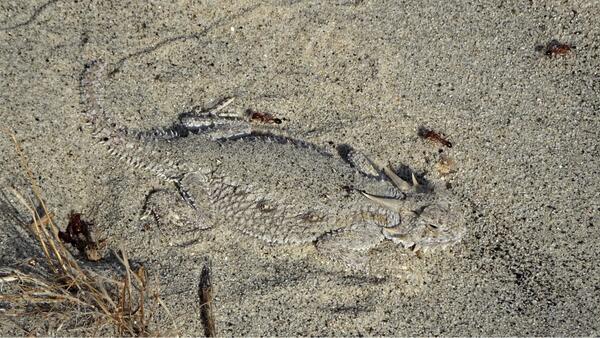Connecting the dots
“Some people feel the rain, other people just get wet.” — Bob Marley
Rainfall is the fuel catalyzing desert plant growth and, through connectivity among all living things, explains the growth or decline of all desert life. The ebb and flow of a population of fringe-toed lizards one year can be predicted by the amount and timing of the rain the year before. Rain germinates annual plants and stimulates growth and flowering in perennial plants. Pollinators visit the flowers, leaf eaters eat the leaves, seed eaters eat the seeds, and detritivores eat the wilted plants and leaves after the plants have completed their brief reproductive cycles. Fringe-toed lizards eat the new leaves and flowers, eat the pollinators, eat the seed eaters, eat the leaf eaters, and eat the detritivores. Lots of rain means lots of plants and means fattened lizards ready to complete their reproductive cycles, potentially yielding multiple egg clutches. The result of the lizards’ successful reproduction, those hatchlings, get counted as part of our annual population assessments the following year.
What works for predicting the ebb and flow of fringe-toed lizards should work just as well for other lizards such as flat-tailed horned lizards. But it doesn’t, at least not for the flat-tails. The horned lizards generally do not eat the new leaves and flowers, the pollinators, the leaf eaters, nor the detritivores. They do eat the seed eaters, the harvester ants. That should be enough to connect them to rainfall fluctuations; more rain, more flowers, more pollinators, more seeds, more ants, and what should then be more flat-tailed horned lizards. Initially I thought perhaps the connection between more rainfall and more flat-tailed hatchlings was severed by the ants. Was there something about the ways harvester ants processed and stored their food that broke the temporal connection between a wet spring and a positive response in ant abundance that same season? Unfortunately, ant ecologists rarely (or never) ask that sort of question and so there were no published studies to offer support or refutation for my hypothesis. Our own annual sampling of ants using dry pitfall traps seemed to support a disconnect between wet years and increased ant abundance, but was that real or was it an artifact of an ineffective ant survey method?
Frustrated, we needed another approach. Scott Heacox created an experiment using captive harvester ants. Basically, the idea was to create a series of artificial “ant habitats,” replicating what people of my generation saw advertised on television our black and white television screens between the Saturday morning cartoons, called “ant farms.” Scott captured newly emerged and impregnated harvester ant queens and put one in each ant habitat. Then half of them were fed seeds from native annual plants, and the other half were only fed seeds from a non-native annual plant, Sahara mustard. We had seen harvester ant workers carrying mustard seeds and seen the workers stripping seeds out of the mustards’ green seed pods (technically called siliques). In both cases there were no limits of how many seeds the queens “harvested.” The results were clear; all queens fed native seeds produced workers, but none of the queens fed just mustard seeds successfully reared any workers. Despite the harvester ants recognizing mustard seeds as potential food (after all, the ants collected mustard seeds) that food did not result in new workers. Perhaps the mustard seeds were too hard for the ants to masticate and convert to food, or perhaps there was a missing essential nutrient. Whatever the case, more mustard, or any mustard, did not produce more ants.
Let’s connect the dots. Since the 1980s, exceptionally wet years, or even just above average rainfall years, especially when the rains began in November or December, resulted in a dense monoculture of Sahara mustard across the flat-tailed horned lizards’ stabilized sand sheet and hummock habitat. Assuming Scott’s experiment translates into patterns in nature, though wet years yielded an increase in primary productivity (plants), but if that primary productivity is primarily Sahara mustard, it would not nourish harvester ants. So, no increase, and likely a decrease in ants, the horned lizards’ food. Wet years did not catalyze more food for the horned lizards, and so the horned lizard population decreased rather than increased as otherwise would be expected. But then why did the fringe-toed lizard populations increase during wet years? First, the mustard never has become a monoculture on the fringe-toed lizards’ preferred habitat, active dune and hummocks; the moving sand and abrasion of seedlings by moving sand keeps the mustard from reaching high densities, leaving ample spaces for native plants to become established. Second, the fringe-toed lizards are diet generalists, not ant specialists. As long as there were palatable plants and other arthropods available, the fringe-toed lizards got fat and produced multiple egg clutches in wet years.
Would the flat-tailed horned lizards have higher densities if the mustard was controlled or eliminated? Yes. Unfortunately, so far there is no method that selectively controls only the mustard at a scale that is meaningful. Hand pulling works, but the number of acres cleared by hand have so far been too small to have a population-level positive impact. The silver lining, if one can call it that, is that especially wet years are uncommon, and becoming increasingly so thanks to climate change. Moderate rainfall levels still germinate native plants, especially if the rains do not begin until January or February, and those natives still support pollinators, and leaf eaters, and seed eaters, and detritivores, but few if any Sahara mustard plants. However, drought conditions, especially severe drought conditions are increasing. During those years the fuel for catalyzing any primary productivity is severed. So far flat-tailed horned lizards and fringe-toed lizards are both sustaining their populations, albeit at lower densities.
Nullius in verba
Go outside, tip your hat to a chuckwalla (and a cactus), think like a mountain, and be safe.

